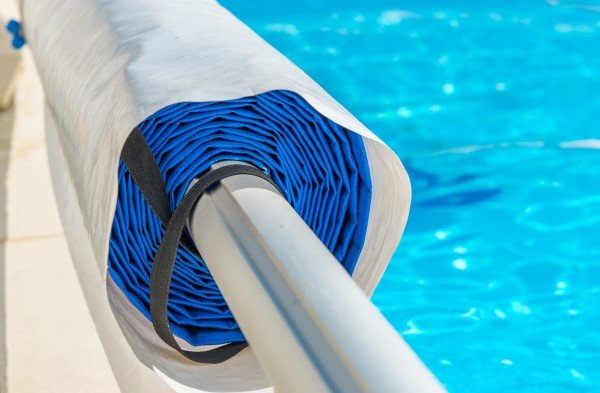As the crisp autumn air sets in and summer fades into memory, pool owners across Northwest Ohio and Southeast Michigan turn their attention to closing their pools for the off-season. Here at Hawaiian Pool Builders, we understand that closing your pool can feel like a daunting task. But fear not! This comprehensive guide will walk you through the essential steps for storing your solar pool cover, ensuring it’s ready to maximize your pool enjoyment next season.
Understanding Your Solar Cover: A Unique Investment
Unlike bulky winter covers, solar covers are lighter and smaller, allowing for easy on-and-off application throughout the swimming season. However, this doesn’t mean they are any less important. Your solar cover plays a vital role in extending your swim season by trapping heat, minimizing evaporation, and reducing chemical consumption. Proper storage during the off-season is crucial for maximizing the lifespan and effectiveness of your solar cover.
Step 1: A Refreshing Clean for a Longer Life
Before tucking your solar cover away for the winter, a thorough cleaning is vital. Here’s how to ensure your solar cover emerges from storage next spring sparkling clean and ready to go:
- Preparation is Key: Find a flat, well-drained area, such as your driveway or patio. Lay the solar cover out flat, ensuring there are no obstructions or debris underneath that could puncture or tear the material.
- The Power of Suds: Fill a bucket with warm water and add a mild dish soap. Dish soap is gentle on the cover’s delicate material while effectively removing dirt, grime, and sunscreen residue. Avoid harsh chemicals like chlorine or pool shock, as these can damage the cover’s UV protection.
- Gently Does It: Using a soft-bristled brush or a push broom with soft bristles, gently scrub the entire surface of the cover in a circular motion. Be careful not to apply excessive pressure, as this can damage the bubbles.
- Rinse and Repeat: Thoroughly rinse both sides of the cover with clean water to remove all soap residue. A light spray from your garden hose should do the trick. Avoid using a pressure washer, as the high water pressure can tear the cover.
- Drying is Essential: Once rinsed, allow the cover to air dry completely. Here are a few tips to expedite the drying process:
- Airflow is Key: If possible, hang the cover over a clothesline, ensuring both sides are exposed to sunlight and air circulation. Flip the cover periodically to ensure even drying.
- Leaf Blower Power: For a quicker drying solution, use a leaf blower on a low setting to remove excess water droplets from the cover surface.
- Sun Power: Lay the cover flat on a sunny surface, but be mindful of leaving it for extended periods, as direct sunlight can damage the cover material over time.
Step 2: Banishing Moisture: The Importance of Complete Drying
Why is complete drying so crucial? Moisture trapped within the cover’s bubbles can lead to the growth of mildew and mold during storage. Mold and mildew are not only unsightly but can also weaken the cover material and create an unpleasant odor. By ensuring your cover is completely dry before storage, you’ll prevent this from happening.
Step 3: Finding a Safe Haven: Storage Solutions for Your Solar Cover
Now that your solar cover is clean and dry, it’s time to find a suitable storage location. Here are a few options to consider:
- Solar Cover Reel: The ideal storage solution for many pool owners is a solar cover reel. These reels allow you to easily roll up the cover when not in use, keeping it protected from the elements and preventing creases or tears. Most reels come equipped with wheels, making them easy to move around for storage in a garage or shed during the off-season.
- The Power of Bags: Many solar covers come with a large, durable storage bag. This is a convenient option, especially if you don’t have a solar reel. Ensure the cover is completely dry before placing it inside the bag to prevent moisture buildup.
- Standing Tall: If you don’t have a reel or a bag, you can store your solar cover upright in a tall trash can. This option works best for smaller covers. Choose a clean, dry can with a secure lid to prevent critters from making a home inside your cover.
Beyond Storage: Additional Tips for Extending the Life of Your Solar Cover
- Chemical Management: Throughout the swimming season, avoid placing chlorine tablets or bromine feeders directly on your solar cover. The concentrated chemicals can damage the cover material.
- Sun Smart: While sunlight activates the heat-trapping properties of your solar cover, prolonged exposure to direct sunlight can deteriorate thematerial over time. When the pool is not in use, consider storing the solar cover off the pool deck or patio to minimize sun exposure.
- Winter Woes: Solar covers are not designed to withstand the weight of heavy snow accumulation. During winter, if you live in an area that receives significant snowfall, it’s best to remove the solar cover from the pool entirely and store it in a protected location.
The Benefits of Proper Storage: A Rewarding Investment
By following these simple storage guidelines, you can ensure your solar cover is ready to tackle another season of extending your swimming season and saving you money on pool heating costs. A properly stored solar cover will last for many years, maximizing your return on investment.
Beyond the Basics: Additional Considerations for Solar Cover Care
For those seeking an extra layer of protection and convenience, here are a few advanced solar cover care tips:
- Solar Cover Protector: Consider investing in a solar cover protector, a specially designed tarp that sits on top of your solar cover when it’s on the pool. This provides additional protection from the sun’s harmful UV rays and helps prevent debris from accumulating on the cover’s surface.
- Regular Inspections: Throughout the swimming season, periodically inspect your solar cover for any tears, punctures, or signs of wear and tear. Early detection and repair of minor issues can help prevent them from becoming larger problems later.
- Replacement Considerations: Solar covers, like any pool equipment, eventually wear out. A good quality solar cover can last for 5-7 years with proper care. If you notice significant fading, cracking, or missing bubbles, it’s time to consider replacing your cover to ensure optimal performance.
By following these comprehensive storage and care recommendations, you can extend the lifespan of your solar cover and maximize its effectiveness for many seasons to come. With a little planning and effort, your solar cover will continue to be a valuable asset in your pool ownership journey.







